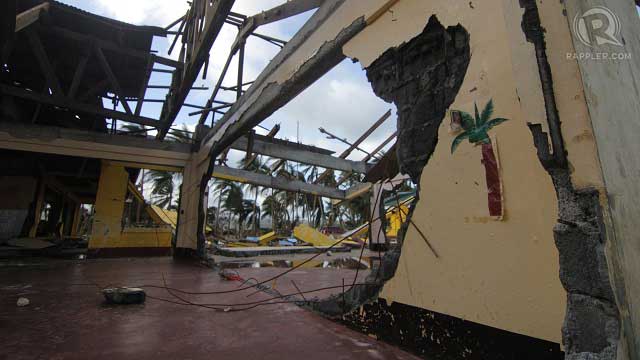SUMMARY
This is AI generated summarization, which may have errors. For context, always refer to the full article.

MANILA, Philippines (UPDATED) – Assessment has been tougher than usual for the Department of Education (DepEd) when, a few days after Yolanda (Haiyan) ravaged parts of the Visayas, communication and power lines were cut off and people on the ground could not be reached.
Nearly two weeks after the disaster, the department finally has exact figures: 3,171 schools damaged by the super typhoon. DepEd Undersecretary Dina Ocampo said these schools across Yolanda-stricken areas incurred damage “of varying degrees”.
“Though [in] our school buildings we consider strength [and] density of cement, of course when you’re talking about [a] super typhoon, [it] is a different matter,” she said in a press conference Thursday, November 21.
Education Secretary Armin Luistro earlier estimated 90% of schools and offices were damaged in Tacloban City alone. In other areas, he said “the damage is either minimal or will not reach 50%”. (READ: Yolanda damaged 90% of school infra in Tacloban – Luistro)
A more comprehensive assessment of school damage is expected Friday, November 22, and will be the basis of the department’s budget and rehabilitation plan.
Prepare, not just repair
An obvious repercussion of disasters like Yolanda and the recent Bohol earthquake is the suspension of classes for extended number of days.
As of Monday, November 18, all classes have already resumed in Region IV-B and Region VII, while in Region VI, only classes in Capiz, Roxas City, Antique, those in the north of Iloilo and 3 districts in Aklan remained suspended.
In Eastern Visayas, the hardest-hit region, the least affected divisions in Northern Samar, Western Samar, and Southern Leyte already resumed classes last Monday.
With only 20 buffer days in its 200-day annual school calendar, the department always encourages schools to resume classes as soon as possible – not only to meet the minimum 180 contact days with students but also to help them recover quickly. (READ: Dear Teachers: Stand tall – not for ourselves, but for others)
“Return to school after disasters can signal the return to normal life…The semblance of going back to the way it was is an important indicator that life goes on,” Ocampo said. (READ: Schools told: Accept students affected by Yolanda ASAP)
But for Margaret Wahlstrom of the United Nations Office for Disaster Risk Reduction (UNISDR), Filipino students are more enthusiastic; in some countries, there are students who no longer return to school after disasters.
Start in schools
“Very often young people feel very marginalized during disasters…Two years ago, after the [Japan] tsunami, students told me: ‘People forget we are not only victims, but we have something important to contribute to society,” Wahlstrom, a special representative of the UN Secretary-General for DRR, said.
Sen Loren Legarda, chair of Senate committees on Climate Change and Environment, said an estimated 66.5 million children are affected by disasters yearly.
“[It is] no longer an issue of how we are able to respond [to disaster], but how we [can] minimize disaster from happening,” she said.
Legarda also suggested for schools to come up with localized, easy-to-understand posters that will list down things to do during disasters. In addition to this, school drills must also be reinforced, particularly those for typhoons and storm surges.
Kabataan partylist Rep Terry Ridon recently filed a resolution for a House inquiry on how disaster risk reduction education may be included in the school curricula, especially in coastal communities “highly vulnerable to disasters.”
“There is a need to teach students essential survival skills, as year after year, students are rendered vulnerable to the risks associated with typhoons and flooding,” he said in the resolution.
Crowdsourcing school safety
The UNISDR also introduced on Thursday a crowdsourcing initiative that will allow communities to assess school safety through the use of technology. (READ: What goes into the building of classrooms)
Status of schools will be mapped with tools like Google Maps for preliminary safety assessment. An app that will help in mapping is already in the works, with a website (www.preventionweb.net/safe-schools) set to go live January next year.
DepEd figures, Legarda said, show 86% of schools in the country have structural defects. The Global Alliance for Disaster Risk Reduction and Resilience in the Education Sector defined a safe school as combining three components:
- structural safety (disaster-resilient infrastructure)
- disaster risk reduction integration in school curricula
- school disaster preparedness
The global project will run until December 2015, with the target of making “every new school” safe from disasters by 2016. – Rappler.com
Add a comment
How does this make you feel?
There are no comments yet. Add your comment to start the conversation.